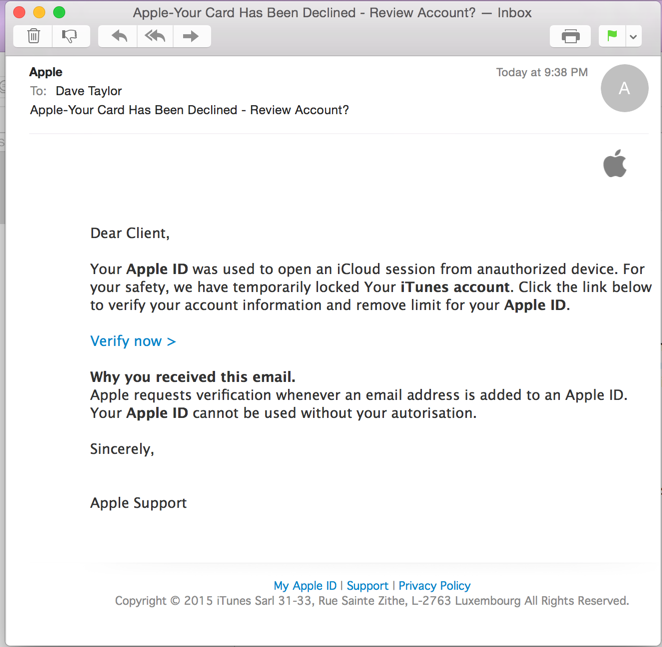

You can fight back against email scammers by having a good virus detection package with a SPAM filter that automatically deletes dodgy emails or puts them in a separate area of your inbox. Never click on any links contained in scam emails as this can give the criminals the opportunity to steal your secure information.Ignore and delete these emails if you are certain the transactions are false. Alternatively contact Apple via their official site. If you get an email receipt from Apple and you are concerned, you should log in to your iTunes account independently of the email and check the transactions on your account. It's a phishing scam and if you enter your personal and financial details, you're at risk of becoming a victim of credit card fraud or identity theft.Ī warning has previously been issued on Australia's hoax-slayer website.Īccording to the information about phishing on the official Apple website: "The iTunes Store will never ask you to provide personal information or sensitive account information (such as passwords or credit card numbers) via email." The costly items and convincing fake receipt are designed to alarm you into clicking on the link to dispute the purchases and attribute them to a hacker.ĭon't even be tempted to click through, as you will simply end up at a bogus website. The email duplicates an authentic iTunes message and features the Apple logo, but is not actually from the Apple store. WA ScamNet has had reports of emails that appear to be from the Apple Store confirming expensive purchases that were made on an iTunes account and containing a link to dispute the purchase. If you receive a fake iTunes purchase receipt, ignore and delete it. Look for “Received: from” right above the “From:” field (e.g.Click on the drop-down arrow in the top right corner.Click on the drop-down triangle in the top right corner.Look for “Received: from” under “Original-recipient” (e.g.
Apple itunes scam email how to#
How to view “Received: from” field or the sending IP address in iCloud, Gmail, Yahoo, Hotmail, and AOL. While this “received: from” field alone can be faked or spoofed, the combination of IP address and passing DKIM on the domain is a the highest security credential an email message can have. Secondly, all Apple messages contain “received: from” (e.g. This is because all IP addresses that follow 17.xx.xx.xx are owned and operated by Apple, Inc. This quick check is the most effective way to validate any messages you might receive from Apple. The table below shows that in all instances the sending IP address starts with the number 17 (e.g. We compiled the most frequent email messages sent from Apple. No friendly Support Community Notifications Most Frequent Emails Sent from Apple Friendly FromĪpp Promotions, App Store Products and release ID and iCloud AlertsĪpple Support Communities Support Communities Updatesįind My My iPhone transactional transactional Alerts (storage, Apple ID, newsletter (Apps, Movies, Spotlight Newsletter While the process might seem highly-technical at first, we’re sure that most people will be able to understand this tutorial quickly and easily. We present to you a thorough guide to determine whether the email message truly originated from Apple, or is actually a scam targeted to gain information about your email account, Apple ID, or even worse – your credit card. Today, almost every Apple user has come across a fake email that appears to have been sent by Apple.


 0 kommentar(er)
0 kommentar(er)
